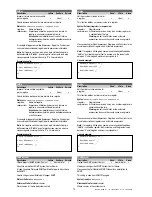
Sintassi (scrittura):
UserLevel(<index>) = <level>
Dove <index> rappresenta l’indice utente nella tabella utenti (0…5), e
<level> è un numero compreso nell’intervallo 0…249 che individua il
livello di accesso di un utente dato.
Gli utenti possono modificare le informazioni di utenti con il loro stesso
livello di accesso o uno inferiore. Ad esempio, un administrator (livelli
da 200 a 249) può cambiare le informazioni dei supervisor (livelli da
150 a 199), ma un supervisor non può cambiare il livello di accesso di
un administrator.
Inoltre, il livello di accesso che si imposta per un utente non può
essere maggiore del livello di accesso dell’utente attuale, visualizzato
dal comando “accesslevel”. Questo è necessario al fine di evitare che
un utente aumenti arbitrariamente il proprio livello di accesso.
Valori suggeriti:
Per semplificare la gestione degli utenti, usate solo i
valori suggeriti qui sotto:
Livello
Valore suggerito
Guest
99
User
149
supervisor
199
administrator
249
Valore di default:
“administrator” (249)
Esempio consolle:
> UserLevel(3) = 99
↵
> UserLevel(3)
↵
99
> _
UserLevelString
Descrizione
Lettura
Scrittura
Salvato
Restituisce la stringa descrittiva del
livello di accesso minimo per un
utente dato
√
×
×
Visualizza una stringa che descrive il livello di accesso di un utente dato.
Si veda il capitolo Gestione Utenti per la descrizione del sistema di
gestione utenti.
Sintassi:
UserLevelString(<index>)
Dove <index> rappresenta l’indice utente nella tabella utenti (0…5)
Valore restituito in lettura:
<levelstring>
Dove <levelstring> è una stringa che indica il livello di accesso
dell’utente come indicato nella tabella qui sotto:
Livello utente
Stringa descrittiva
Da 0 a 99
guest
Da 100 a 149
User
Da 150 a 199
supervisor
Da 200 a 249
administrator
Esempio consolle:
> UserLevel(3) = 99
↵
> UserLevelString(3)
↵
guest
> _
Syntax (write):
UserLevel(<index>) = <level>
Where <index> represents the user index in the users table (0…5), and
<level> is a number in the range 0…249 indicating the access level of
the given user.
Please note that operators are only allowed to change information of
users with their same or lower access level. For example, an
administrator (level 200…249) can change supervisors information
(level 150…199) , but a supervisor cannot change the access level of
any administrator.
Furthermore, the access level set for an user cannot be greater than
the current access level of the operator, stated from the “accesslevel”
command. This is necessary to avoid that an operator arbitrarily elevate
his proper access level.
Suggested Values:
To simplify users management, please use only
the following suggested values:
Desired Level
Suggested Value
guest
99
user
149
supervisor
199
administrator
249
Default Value:
“administrator” (249)
Console example:
> UserLevel(3) = 99
↵
> UserLevel(3)
↵
99
> _
UserLevelString
Description
Read
Write
Saved
Return the minimum access level
descriptive string for a given user
√
×
×
Displays a string describing the access level of the given user.
Please see chapter User Management for a description of user
management system.
Syntax:
UserLevelString(<index>)
Where <index> represents the user index in the users table (0…5)
Returned value for read:
<levelstring>
Where <levelstring> is a string indicating the access level of the given
user as indicated in the table below:
User Level
Descriptive String
From 0 to 99
guest
From 100 to 149
user
From 150 to 199
supervisor
From 200 to 249
administrator
Console example:
> UserLevel(3) = 99
↵
> UserLevelString(3)
↵
guest
> _
75
Manuale WebGate - cod. +030220230 rel. 1.0 - 16.09.2003
























